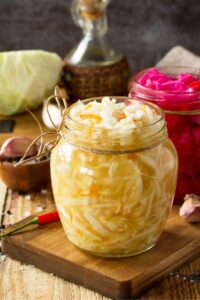Description
Alton Brown’s sauerkraut recipe delivers a tangy fermented delight straight from German culinary traditions. Home cooks can easily create this probiotic-rich condiment with simple cabbage and salt, delivering complex flavor in minimal preparation time.
Ingredients
Scale
- 5 lbs (2.27 kg) green cabbage, shredded
- 3 tbsps (45 ml) pickling salt
- 1 tbsp (15 ml) juniper berries
- 2 tsps (10 ml) caraway seeds
- 1 quart (0.95 l) water, in a sanitized glass jar
Instructions
- Preparation: Meticulously shred cabbage and blend with kosher salt, juniper berries, and caraway seeds, massaging ingredients thoroughly to ensure comprehensive coating and moisture release.
- Compression: Pack the seasoned cabbage mixture densely into a clean fermentation container, eliminating air pockets by pressing firmly with hands or a specialized tamper to create an anaerobic environment.
- Weighting: Place a slightly smaller lid directly on the cabbage surface, then position a water-filled glass jar on top to generate consistent pressure and maintain ingredient submersion during the fermentation process.
- Fermentation Zone: Position the container in a stable environment with consistent temperature between 65-70 degrees Fahrenheit, which creates ideal conditions for microbial activity and flavor development.
- Monitoring: Inspect the fermentation process every 48 hours, carefully removing any surface foam or residue while ensuring cabbage remains completely submerged in its generated liquid.
- Progression: Allow the sauerkraut to ferment for approximately 4 weeks, permitting complex flavor profiles to emerge and beneficial bacterial cultures to multiply and transform the vegetable mixture.
- Preservation: Upon completion of fermentation, transfer the sauerkraut into sterilized glass containers and refrigerate, where it can be safely stored for up to 6 months, maintaining its robust and tangy characteristics.
Notes
- Sanitize Everything: Ensure all equipment, hands, and surfaces are meticulously cleaned to prevent unwanted bacterial contamination during fermentation.
- Monitor Temperature Carefully: Maintain a consistent 65-70°F environment, as temperature fluctuations can disrupt fermentation and impact final flavor profile.
- Watch for Mold Signals: Immediately discard the batch if any unusual discoloration, fuzzy growth, or off-putting odors appear during the fermentation process.
- Press Firmly and Consistently: Use substantial pressure when packing cabbage to eliminate air pockets, which helps create an anaerobic environment essential for proper fermentation.
- Prep Time: 20 minutes
- Cook Time: 0 minutes
- Category: Lunch, Dinner, Appetizer
- Method: Fermenting
- Cuisine: American
Nutrition
- Serving Size: 10
- Sugar: 0 g
- Sodium: 10500 mg
- Fat: 0 g
- Saturated Fat: 0 g
- Unsaturated Fat: 0 g
- Trans Fat: 0 g
- Carbohydrates: 1 g
- Fiber: 1 g
- Protein: 0 g
- Cholesterol: 0 mg
